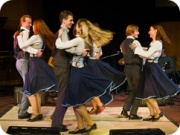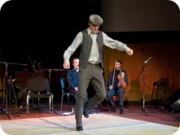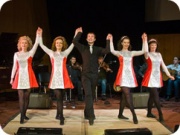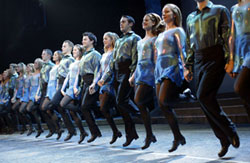
Foreword
Over the past ten years, Irish traditional culture has penetrated significantly, if not into the broad masses of the Russian public, then at least into a “narrow circle.” And if earlier this topic caused only one association to the average person - Riverdance, now you can’t guess, the interlocutor is already dancing sets, or maybe his children are competing in fashi for the first place in light jig.
That is, many, at least, know that Irish dancing can be very different. Nevertheless, not everyone has a solid idea of the relationship of the types of Irish dancing to each other, but the most popular question asked to any Irish dance teacher is: “Do you teach jigging?”. In addition, differences in aspirations, approaches and goals, characteristic of dancers of different directions (social, sports and shows), from time to time, give rise to controversy about whose Irish dances are the most Irish.
I would like to dwell on the outline of the general picture of the Irish dance life, as well as on the understanding of the tradition that stands behind each of the types of popular dance now. However, before we talk about the current situation, let's quickly go over the history of Irish dancing. She not only clearly shows that there are no “more real” Irish dances compared to “less real” dances, but also dispels some of the myths repeated with a zeal worthy of better use.
A very brief history of Irish dance
Actually, the history of Irish dance, albeit rich and dramatic, is not as long as it may seem. Any written mentions that allow any concrete answer to say “what” and “how” the Irish danced in the past appear no earlier than the beginning of the 18th century. There is every reason to say that dancing as an art form appeared and spread in Ireland much earlier (at least from the XIV, and more likely from the 9th century), but what these were and how they looked, there is absolutely no information. So, all attempts to see the rites of the Druids in Kaley-dances, and in sets of - sun worship are the essence of cute but baseless fantasies (well, that is, again, you can search for roots, elements and typology, but we haven’t followed any direct connection yet we can). Well, the “ancient Celtic dances” is obviously a commercial one, which has nothing in common with the historical material of the term.
But from the beginning to the middle of the XVIII century begins the lively documented life of Irish dances, which led to the current wealth and diversity of their types. At this moment, French quadrille appears in Ireland, and the French (at least in the first stage) dance masters. Both those and others, not being born in Ireland, got accustomed on the grounds of the Emerald Isle and changed so much that they became an integral and bright part of Irish culture.

The quadrille, having undergone significant changes in music and technique steps, turned into what we now know as Irish sets . It is worth noting that after they had finally become “sets”, that is, purely Irish dances (this most likely happened by the middle and end of the XVIII century), they practically ceased to change in form, technique and living environment. The sets formed the main base of “social” dances - that is, dances for socializing, spending time and having fun. An exception is the course of "competitive" sets, but it requires a separate conversation.
The dance masters brought to the Irish soil an already developed European training system, a system for recording steps, movements and dances. They taught mostly solo and pair dances, paying particular attention to technique, body form, and so on. It was the dance masters who raised the Irish dancers to the half-toes and began to consciously invent new complex movements and elements, as a result creating a tradition, the apex of which are modern solo dances.

Another peculiar phenomenon in the Irish dance life was very little known before the beginning of the twentieth century, Shan Nose (not to be confused with Shan Nose singing). Originally, Shan-Nose is both a dance style and a way of being / transmitting a dance culture, which appeared in the west of Ireland in a region called Connemara. These are solo dances, which are based on improvisation in principle, and they have not been taught in principle to the modern history. The one who wanted to dance, looked at other dancers and adopted movements independently.

These layers coexisted peacefully until the end of the 19th – beginning of the 20th century, practically without intersecting when the Gaelic League drew attention to the dances and soon created the Well Irish Dancing Commission (Coimisiún le Rincí Gaelacha) that still exists. At this moment, in addition to solo-dance couples, sets and Shan-nos, large-scale group dances, Keili, were created. But in general, the "new" history of Irish dance began. In this new story, certified teachers and organized schools appeared, where children were taught keyley and solo, and most importantly, numerous competitions - feshes. It was at this moment that the competitive component in the Irish dances became “official”, and sometimes dominant, turning dances into sports for many. And during the XX century, the average age of the dancer began to decline steadily, the technique became more complex, the rules and formalities multiplied. However, before the worldwide explosion of popularity was still far away.
In parentheses, we note that it was with the advent of the “authoritative” organ that the question “what is“ real ”Irish dancing” first appeared and the first attempts to make the history of the dance appear, to appoint druids and fairy to the progenitors, etc. As a result, a long, sometimes comical, sometimes tragic confrontation with Kaylee-solo and sets began. Fortunately, this confrontation was somehow overcome by the end of the 50s – 60s of the 20th century, and now no adult Irishman would think of what kind of dances are “more Irish”.
 The next milestone that translated the dances into the “newest” era was the resounding success of Michael Flatley’s show, Riverdance, and then Lord of the Dance. It was this success that ensured the worldwide popularity and recognition of Irish dancing. In the success of these projects it is important to note several details: the popularity of the show greatly helped the Irish dance not only to gain a world name, but also gave a serious impetus to the development inside the country. The soloists and creators of “Riverdance”, Michael Flatley and Gene Butler, had many years of study in those same modern-style schools “honed” for competitions, and by the launch of the show were repeated winners of the championships. With their success, they showed that a child involved in Irish dancing has ways in addition to the two standard ones - to become a teacher or forget dancing as a childish hobby.
The next milestone that translated the dances into the “newest” era was the resounding success of Michael Flatley’s show, Riverdance, and then Lord of the Dance. It was this success that ensured the worldwide popularity and recognition of Irish dancing. In the success of these projects it is important to note several details: the popularity of the show greatly helped the Irish dance not only to gain a world name, but also gave a serious impetus to the development inside the country. The soloists and creators of “Riverdance”, Michael Flatley and Gene Butler, had many years of study in those same modern-style schools “honed” for competitions, and by the launch of the show were repeated winners of the championships. With their success, they showed that a child involved in Irish dancing has ways in addition to the two standard ones - to become a teacher or forget dancing as a childish hobby.
In addition, the show greatly influenced the style and technique of dance, causing another round of increase in speed, complexity and entertainment. And of course, “Riverdance” inspired many talented and not very followers to create their own projects of various scales, many of which are very far from any (sports, social) tradition.
Summing up and turning to the current situation, it must be emphasized that any type of Irish dance has a relatively long history. Therefore, the question of what kind of dances “real Irish” absolutely does not make sense. Differences can and should be sought in a different plane. And in what, we will talk in the second part of the article.
to your site.




